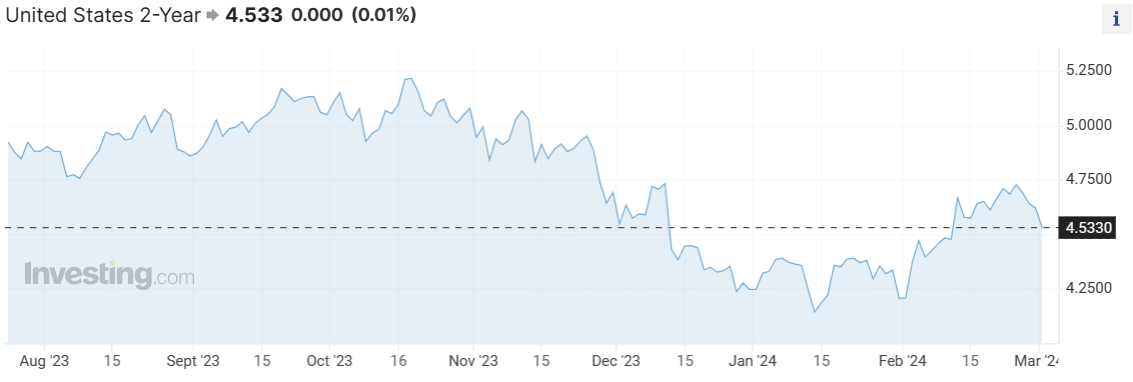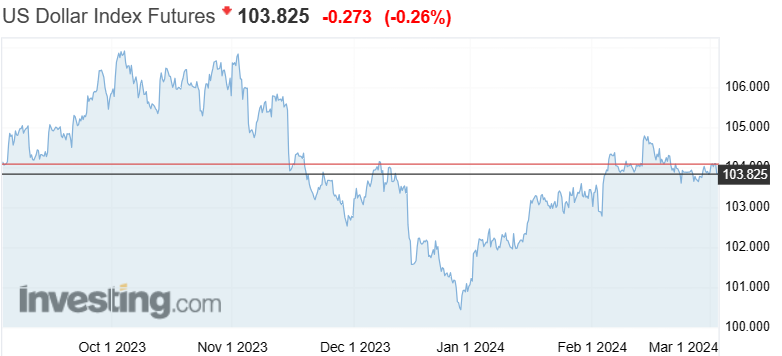
Summary of key points: -
- Lead indicator for the US dollar value turns downwards again
- RBNZ shift on inflation from hawkish to complacent
Lead indicator for the US dollar value turns downwards again
The most accurate way to describe US economic data since the start of the year would be “mixed”.
The positive and negative surprises compared to prior forecasts balancing-off against each other. As a result, the foreign exchange markets are not any clearer as to whether the US economy is softening compared to conditions in 2023, or not. US market interest rates are, however, higher today than December when the Fed pivoted on monetary policy settings from “tightening“ to “loosening”. The two-year and 10-year bond yields increased on the much stronger than expected January Non-Farm Payrolls jobs data released in early February. Higher than forecast wholesale PPI prices in mid-February added to the market sentiment and perception that inflation still had some risks of increasing again. Therefore, the market pricing for the timing of the first Fed cut to interest rates has progressively moved out from March to June.
The mixed positive and negative signals coming from the US economic data has left the US dollar value rangebound over the last two months between 103.00 and 104.60 on the USD Dixy Index. Countering the stronger jobs data was very weak US retail sales numbers in January. As a consequence, the New Zealand dollar has been unable to hold above 0.6200, however it has considerable support at the 0.6050 level. The sideways shuffle of both rates is unlikely to continue for too long.
An important lead-indicator for the future direction of the US dollar value is their two-year bond yield, which continuously prices-in the probability and timing of changes to the Fed Funds interest rate. The two-year bond yield nosedived from 5.25% in October 2023 to a low of 4.15% in early January as the rapid decline in US inflation allowed the Fed to pivot on monetary policy. Since early January the financial markets have started to have doubts and second thoughts as to the timing and speed of Fed interest rate cuts in 2024, mainly because some of the economic data has been stronger than anticipated (e.g. employment). The two-year bond yield, as a result, as lifted from 4.15% to a high of 4.75% on 26 February. The USD Dixy Index currency movements have mirrored the changes in the US two-year bond yield over these last two months. The USD appreciated from 100.50 on the Dixy Index in early January to a high of 104.80 in mid-February (refer charts below).
Over this last week the direction of the US two-year bond yields has reversed abruptly, dropping back from 4.75% to 4.53% as the economic data that was released did not really support Fed interest rate cuts being delayed to much later in the year. Sitting at 103.82, the USD has not yet reacted to follow the lower bond yields of recent days. It seems inevitable that it will do so over coming weeks, particularly if the economic data continues to print on the softer side.
US PCE headline inflation data for January released on Thursday 29th February was bang-on prior forecasts at +0.30% for the month, reducing the annual headline rate from 2.60% to 2.40%. Many market participants were braced for a higher outcome. That did not eventuate, and US inflation continues its steep and consistent track lower to the 2.00% Fed target. Earlier in the week, durable goods orders for January were significantly weaker, down 6.10% (compared to a -4.00% forecast). At the end of last week, the US ISM Manufacturing PMI Index was also much softer than expected, dropping to 47.8 against a forecast of 49.5. New manufacturing orders in the ISM survey were also very weak at 49.2, well below the 52.5 forecast.
The focus this week will be Federal Reserve Chair, Jerome Powell’s testimony in front of Congress on Thursday 7th March, ISM services results Tuesday 5th March and Non-Farm Payrolls jobs data on Friday 8th March. Consensus forecasts are for a much lower increase in jobs in February of 200,000, compared to the spuriously outsized increases of 333,000 and 353,000 for the December and January months respectively.
A continuation of weaker than forecast US economic data as the tight monetary conditions over the last 12 to 15 months finally bite, is set to push the two-year bond yield lower towards 4.00%. The USD Dixy Index will follow the interest rates lower, resulting in more upside for the NZD/USD exchange rate from here (0.6110), than downside over coming week/months.


RBNZ shift on inflation from hawkish to complacent
In their wisdom, the RBNZ have done it again!
In an inflation environment where they desperately need a higher NZ dollar currency value to push tradable inflation lower to offset the permanent 3.00% to 4.00% non-tradable inflation, they produced a monetary policy statement with an unexpected “dovish-tilt” that drove the NZ dollar downwards! The markets expected another “hawkish” stance from the RBNZ last week as that would have been entirely consistent with their November statement and the tone of RBNZ Chief Economist Paul Conway’s speech on sticky domestic inflation at the end of January. But no, it was not to be! From past performances we all should have known that Governor Orr would take the opportunity to, yet again, wrong-foot the markets. Consistency is not a strong trait at the RBNZ.
According to the RBNZ February statement, the economy is contracting, and inflation is decreasing exactly as they anticipated it would be at this time. “Trust us”, “we have got this” and “everything is “hunky-dory!” seems to be the RBNZ mantra. Revisions to historical GDP data has apparently provided the RBNZ with more confidence that there is more spare capacity in the economy than what they earlier estimated, which allows inflation to reduce earlier. There is considerable evidence in employment and wages data that suggests the RBNZ are again being far too complacent on the inflation outlook (even though the economy may be in recession). Public sector wage increases for the year to 31 December were over 6.00%. These ongoing cost increases in the public sector are automatically being passed through into higher prices for households. The high wage-pushed domestic inflation is not suddenly going to fall away in 2024 as the RBNZ seem to be predicting. The lack of demand in a recessionary economy makes no difference to this supply-side price setting behaviour.
The dramatic increase in business confidence in New Zealand over recent months does suggest that business investment will be much more positive this year than RBNZ forecasts of very little business investment. The RBNZ are forecasting the next three quarters’ (March, June and September) inflation increases to be 0.40%, 0.60% and 1.20% respectively, reducing the current 4.70% annual inflation rate to 2.60% by 30 September. It seems a big ask that the next three quarters will average a 0.70% increase per quarter, whereas the last eight quarters have averaged an increase of +1.50% per quarter. Without a significant NZ dollar appreciation (weaker USD) to reduce imported/tradable inflation over coming months, the RBNZ will be forced to revise their 2024 inflation forecast higher.
Daily exchange rates
Select chart tabs
*Roger J Kerr is Executive Chairman of Barrington Treasury Services NZ Limited. He has written commentaries on the NZ dollar since 1981.
4 Comments
It seems a big ask that the next three quarters will average a 0.70% increase per quarter, whereas the last eight quarters have averaged an increase of +1.50% per quarter.
The last 4 quarters have averaged 1.15%, with the last quarter coming in at 0.5%. Why would you look at data from 8 quarters (2 years ago)?!
The dramatic increase in business confidence in New Zealand over recent months does suggest that business investment will be much more positive this year than RBNZ forecasts of very little business investment.
We'll see. But in the face of a contracting economy and squeezed revenues most business will not be investing in their businesses no matter how much confidence they have. The investment will come, but at the 'turn' when there is sufficient evidence that the business will survive (and the owners have received their profits which usually comes before growing the business in NZ).




We welcome your comments below. If you are not already registered, please register to comment.
Remember we welcome robust, respectful and insightful debate. We don't welcome abusive or defamatory comments and will de-register those repeatedly making such comments. Our current comment policy is here.